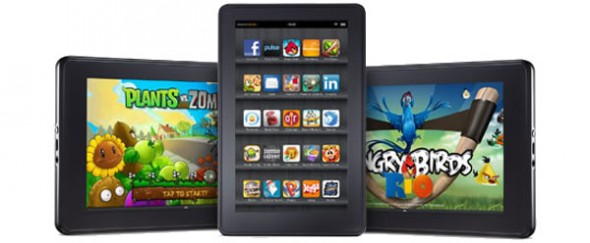
Prior to the launch of Amazon’s £199 Kindle Fire, many in the media were calling it a possible iPad killer, but that is not really the case. Yes it may take a good part of the tablet market away from Apple, but not because it is competing with the iPad on features – but because of its very cheap price-point, and that it was created from the ground up as a pure media consumption device.
The most striking thing about the Kindle Fire is the price – just £199 (or $199 in the US) is an absolute bargain for a media consumption device with a 7″ screen that can play back most video and music formats with ease, and has deep and easy integration with a content supplier in Amazon. Amazon’s content options are in reality the only real competitor to Apple’s iTunes ecosystem – making ease of use and integration to the point of sale and download very important factors.
It is surprising how little storage Amazon are offering with the Kindle Fire – just 8GB on no SD expansion slot. This may be enough for 80 apps along with either 10 movies, 800 songs, or 6,000 books – but it is definitely a limiting factor. The reason for this lack of capacity is likely due to Amazon wanting to sell cloud content to the device such as streaming music, tv, or films – but users are not always near a WiFi connection. All digital content is stored by Amazon in their cloud for streaming at any point in the future from the Kindle Fire or other devices, but WiFi is not ubiquitous and accessing this cloud content will be difficult at times.
It is an interesting thought that Apple and Amazon have almost mirror opposite tablet strategies, with Amazon discounting the tablet probably at a loss in order to sell more content, and Apple selling content without making much profit at all in order to sell more high-margin iPads, iPhones, and iPod Touches. Both of these methods, however, rely on deep integration between the tablet and the content in order to sell the products they are making a profit on.
Another interesting addition to the Fire is Amazon’s own Silk web browser which makes use of its own proprietary split browser architecture system to shift the browser’s processing to Amazon’s EC2 cloud. With EC2 doing the hard work and constantly connected to the internet backbone, the theory goes that transit times will be reduced, and things like running Adobe Flash content will not burn through the battery life as all computationally intensive tasks are run in the cloud. It’s a clever idea and builds on the ideas of opera’s mobile browser that shrinks web pages before sending them to the browser – but with Amazon having access to everything you do/see on the internet will cause some to have privacy concerns.
Various iPad users will tell you that the iPad has changed the way they work, or made their life easier for this reason or that – but the simple fact is that a good proportion of iPad users, make use of the tablet to watch videos, listen to music, playing games, and to surf the web when sitting on the sofa or on the train. Yes the iPad can do a huge amount of things, but most people only use a handful of them. The Kindle Fire is targeted at just those features that people do regularly use – the media playing, and web browsing. It has a slower processor than the iPad, a smaller screen, and less storage – but it is also under half the price. The question now is whether people value the Apple brand and those rarely used bells and whistles more than price.


Pingback: Amazon Launches 4 New Kindles Including Touch And Fire | TechFruit
Pingback: Kindle Fire Competitor ViewSonic Viewpad 10e Is Just £199 | TechFruit